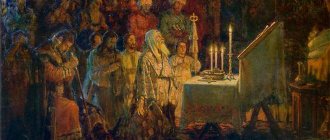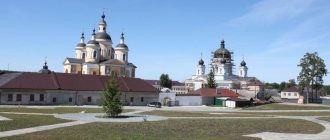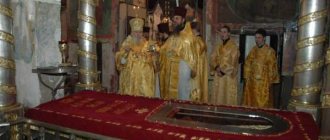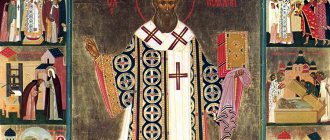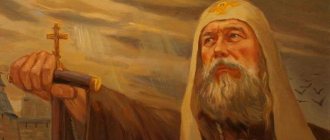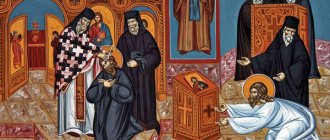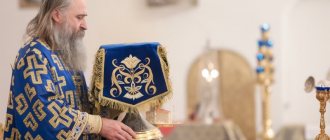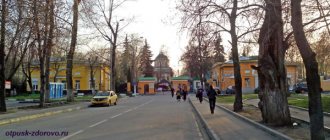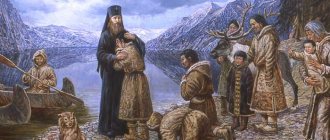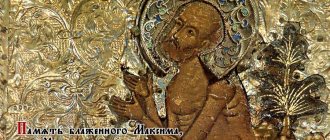In the photo: Saint Alexy, Metropolitan of Moscow. Fragment of the painting of the Church of the Nativity of Christ in Izmailovo.
In the Elokhovsky Epiphany Cathedral in Moscow reside the relics of St. Alexy, Metropolitan of Moscow, the great holy wonderworker of Russia. Saint Alexy, Metropolitan of Moscow, is highly revered for this Russian saint, who played a vital role in the ancient history of Russia.
Metropolitan Alexy of Moscow was born in Moscow at the turn of the 13th-14th centuries into a prominent boyar family and received the name Simeon at baptism. His godfather was the young prince John, the future Grand Duke of Moscow Ivan Kalita. Subsequently, the godfather and his godson were destined to bring their hometown to the forefront in Rus', forming here the unifying center of a fragmented country groaning under the foreign yoke.
In a dream, the future Metropolitan Alexy of Moscow heard a voice saying that the boy was wasting his time on empty labors, catching birds, while his purpose was to “catch people.” From then on, Eleutherius began to visit church often.
Saint Alexy, already at the age of 19, received monastic tonsure from the elder brother of the Monk Sergius of Radonezh, Abbot Stephen. This happened in the Epiphany Monastery, then a suburban monastery, but now located in the very center of the capital, on the territory of Kitay-Gorod.
Monk Alexy was distinguished by excellent abilities, and, having reached the age of forty, he began to be considered the official successor of the elderly Metropolitan of Kyiv Theognostus. It should be noted that the title “Kiev” by that time was already of a purely nominal nature, and the metropolitans lived in Moscow from 1325.
Saint Alexis goes to Constantinople
In 1354, Bishop Alexy went to Constantinople, where at that time the Russian high priests were undergoing the procedure for their approval. The Ecumenical Patriarch approved his nomination as a metropolitan as an exception - at that time, the majority of Russian primates of the Church were chosen from the Greeks. Patriarch Philaret of Constantinople elevated Alexy to the rank of Metropolitan of Kyiv and All Rus'.
On the way back from his second trip to Constantinople (undertaken to resolve a dispute with the Lithuanian Metropolis, which had separated from the Kiev Metropolis), Saint Alexis found himself in a strong storm and vowed, if rescued, to found a monastery in Moscow. This is how the subsequently famous Spaso-Andronikov Monastery appeared in the capital.
Returning to Rus', Metropolitan Alexy acted energetically - he installed new bishops, fought against internal church discord, and through his own actions showed his flock an example of Christian life. It was under him that the residence of Russian metropolitans was moved from Kyiv to the northeast of the country.
Russian Orthodox Church
The Holy Wonderworker Alexy, Metropolitan of Russia, came from a boyar family. His parents, Theodore and Maria, were boyars of the Chernigov principality. Saint Alexy was born in Moscow under the Moscow prince Daniil Alexandrovich, whose son and heir, Prince John Daniilovich, then still a youth, was Alexy's successor in Holy Baptism, at which the baby was given the name Eleutherius. When he grew up, he was given to teachers for book teaching. One day, when Eleutherius was 12 years old, he was setting up nets in a field to catch birds. At this time, the boy accidentally fell asleep and heard a voice: “Why, Alexy, are you working in vain? I will make you a fisher of men."
Waking up from sleep, the youth saw no one around and was very surprised at what he heard. From that time on, he began to think and reflect a lot on what this voice should mean. Having loved God from a young age, he left his parents, refused to marry, and, wanting to serve the one Lord Christ, came to the Epiphany Monastery in Moscow, and here he tonsured himself a monk, and in tonsure he was given the name that he heard in a dream vision , - Alexy. Then the abbot of the Epiphany Monastery was Stefan, the brother of the great wonderworker Sergius of Radonezh; He himself tonsured Saint Alexis, who was then in his twentieth year.
From that time until the age of forty, Saint Alexy worked tirelessly, fasted, prayed every night and practiced other monastic feats, so that many marveled at his zeal. For his godly life, everyone revered and respected Saint Alexis, even the Grand Duke of Moscow Simeon Ioannovich himself and Metropolitan Theognost loved him very much. For many virtues he was made bishop of the city of Vladimir.
When Metropolitan Theognostus reposed, the Grand Duke of Moscow John Ioannovich, who took the reins of government after his brother, Grand Duke Simeon, by a conciliar decree, elected Saint Alexis as metropolitan and sent him for initiation to Constantinople to His Holiness Patriarch Philotheus. Philotheus appointed Saint Alexis Metropolitan of Kyiv and All Russia. Upon his return from Constantinople, Saint Alexy took upon himself the management of the Russian Church and began to strive even more, adding others to one deed, and was a lamp for everyone, setting an example in word, deed and life, faith and purity, spirit and love.
Despite all the troubles, Saint Alexy took every possible care of his flock - he installed bishops, established cenobitic monasteries (modeled on Trinity, founded by St. Sergius), and established relations with the Horde khans.
The fame of Saint Alexis spread not only among Christian believers, but even among infidel Mohammedans who did not know Christ. At that time, the wife of Tatar Khan Janibek Taidul had lost her sight for three years. Hearing that God works many miracles through the prayers of Saint Alexy, Janibek sent to the Grand Duke of Moscow Dimitri Ioannovich with a request that he send this man of God to him, so that by praying for his queen to God, he would give her insight. At the same time, Janibek added: “If the queen receives healing through the prayers of that man, you will have peace with me. If you do not send him to me, then I will destroy your land with fire and sword.”
When Dzhanibek’s petition arrived in Moscow, Saint Alexy was grieved, considering this a matter beyond his strength. But, at the request of Grand Duke Dimitri, he nevertheless went to Khan Janibek. Before his departure from Moscow, he performed prayer singing with the clergy in the cathedral church in honor of the Dormition of the Blessed Virgin Mary. During this prayer service, the candle at the tomb of the holy wonderworker Peter lit itself, and everyone saw this miracle. From this Saint Alexy understood that the Lord was pleased to announce to him that his journey would be prosperous. Taking some of the wax from that candle and making a small candle from it, the saint, together with his clergy, began to prepare for the journey, firmly trusting in the mercy of God.
Even before the arrival of the blessed one in the capital of the Mongols, the queen, in a sleepy vision, saw Saint Alexis of God in bishop's clothing, accompanied by priests. Having awakened, she immediately ordered that precious vestments be made for bishops and priests according to the model she had seen in her dream vision. When Saint Alexy approached the capital of the Tatars, Janibek came out to meet him with great honor and led him into his chambers. The saint, having begun the prayer singing, ordered the lighting of the small candle that he had taken with him. After a long prayer, he sprinkled sacred water on the queen, and she immediately received her sight. The Khan with his nobles and everyone who was there were greatly amazed at this wondrous and glorious miracle and sent praises to God. Having honored Alexy and those with him and generously rewarded them, Janibek sent them away in peace.
Returning from the Horde, Saint Alexy, after some time, was forced to go to the Horde again. Khan Janibek died, and his cruel and bloodthirsty son Berdibek ascended his throne. Having killed his 12 brothers, he wanted to go with his army to Russian land. Then, at the request of Grand Duke John, Saint Alexy went to the Horde to see Berdibek and with his meek, reasonable conversation tamed the rage of the cruel khan. Having petitioned the formidable ruler for peace for Christians, Saint Alexy returned to Moscow, for the throne of the Kiev Metropolis was transferred here by Saint Peter, Metropolitan of Kiev, as a result of frequent wars and invasions of barbarian peoples.
When Grand Duke John died, guardianship over the minor Prince of Moscow Dimitri Ioannovich (future Grand Duke Dimitri Donskoy, commemorated May 19/June 1) fell on the saint’s shoulders. The power of the Grand Duke was begged for himself in the Horde by the Suzdal prince Dimitri Konstantinovich. The saint was supposed to bless the Suzdal prince for his great reign, but refused to fulfill the request of the Grand Duke to live in Vladimir, remaining a protective father for the young prince Dimitri Ioannovich. Meanwhile, there was unrest in the Horde; every year several khans appeared and exterminated one another; in 1362 two rival khans appeared. Young Dimitri begged from one of them the title of Grand Duke of Rus' and forced Dimitri Konstantinovich to leave Vladimir. Saint Alexy joyfully blessed his pet for his great reign with the miraculous Vladimir Icon of the Mother of God. He was the soul of all the affairs of Prince Demetrius; through the works of the saint, the power of the Grand Duke of Moscow grew and strengthened.
Saint Alexy was engaged in the construction of monastic monasteries. So, he built a temple on the banks of the Yauza River in the name of our Lord Jesus Christ, in honor of His Image Not Made by Hands, built a monastery at this temple and introduced a communal charter in it. He entrusted the eldership of the new monastery to Andronik, a disciple of the holy wonderworker Sergius. In addition to this monastery, Saint Alexy built other churches and monasteries in Moscow and other Russian cities. So, he built a stone church in Moscow in the name of the Holy Archangel Michael, in honor of his glorious Miracle that happened in Khoneh, and built a monastery, which is still called Chudov; here the saint commanded to lay his body.
Saint Alexy transformed the women's monasteries, placing independent abbesses at their head. Before his time, women's monasteries depended on men's. With his new charter, he brought them to prosperity. Under him, several convents were created in Moscow according to his charter. The graves of his sisters Eupraxia and Julia were honored in the Conception Monastery. One of them was the abbess. The charter of Metropolitan Alexy was finally approved by the Stoglavy Council in 1551 and became mandatory.
Saint Alexy did many other deeds worthy of memory, glorious and wondrous, for the glory of God and kindly shepherded his verbal flock until his death.
Having foreknowledge of his departure to the Lord, the saint performed the Divine Service and received communion of the Holy Mysteries. Wishing everyone to be in peace, he gave everyone his last kiss and calmly surrendered his soul to the Lord on February 12, 1378. The great minister occupied the Holy See for 24 years, but his entire life was 85. With due honor, his body was buried in the temple he created in the name of the Archangel Michael in the chapel of the Annunciation to the Blessed Virgin in the Miracle Monastery.
Many years later, his holy and multi-healing relics were found completely incorruptible. Even the vestments on the deceased saint were completely intact, as if they had been put on the day before.
The relics of St. Alexy were transferred to the Archangel Cathedral, and in 1947, in connection with preparations for the celebration of the 800th anniversary of Moscow, at the request of Patriarch Alexy I, they were transferred to the Epiphany Cathedral in Yelokhov, where they still rest today.
From them, to this day, many healings flow, as if from an inexhaustible source, and his holy prayers provide help to all who come to them with faith.
Based on materials from the website “Orthodoxy and Modernity”
Alexy Moskovsky goes to the Horde to treat Khansha Taidula for an eye disease
By 1357, rumors about the outstanding merits of the Russian metropolitan reached the Horde, and Khansha Taidul, who was suffering from an eye disease, invited him, hoping for a cure. Through the prayers of the saint, the ruler received healing and freed the Church from Horde exactions. In gratitude for this, the saint was granted land in the Moscow Kremlin, where there was an inn for Horde ambassadors. Here Alexy founded the Chudov Monastery.
In Moscow by that time, Metropolitan Alexy enjoyed enormous influence and was actually a co-ruler of the state. It was at his initiative that in the 60s of the 14th century the construction of the white stone Kremlin, which until then had been wooden, began. In addition to Spaso-Andronikov, the saint blessed the founding of the famous Chudov and Simonov monasteries in Moscow, as well as the Vvedensky Vladychny Monastery in Serpukhov, and contributed to the introduction of the practice of communal monasteries, which in this era were founded in different parts of the country by the disciples of St. Sergius of Radonezh.
After the death of Prince of Moscow Ivan II
After the death of the Grand Duke of Moscow Ivan II the Red, Alexy of Moscow took his young son Dmitry (the future Donskoy) under his wing. Having become the de facto ruler of Rus', he constantly resolved disputes among the appanage princes, trying to unite them among themselves.
Around the same time, power changed in the Horde. Janibek was killed by his own son, who demanded that the Russian princes increase the amount of tribute collected. And then Metropolitan Alexy of Moscow again went to the Horde, to Taidula. At his request, she undertook - and quite successfully - to persuade her son to change his anger to mercy.
In Moscow, the bishop was greeted with honors, and the young Prince Dmitry exclaimed:
“O lord! You have given us a peaceful life, how can we express our gratitude to you?”
Origin and early years
The future Metropolitan Alexy Byakont was born at the end of the $13th century, the exact date is unknown - between $1292$ and $1305$.
His parents were of a boyar family, his father was Fyodor Byakont, his mother’s name was Maria, they came from Chernigov. The Byakont family occupied a high position in Moscow. The name given to the boy at birth differs in the sources: in the life he is called Eleutherius, and in earlier sources he is called Simeon. According to the Life of Metropolitan Alexy, written in $1459 by Pachomius Logofet, he mastered literacy at an early age and wanted to enter a monastery.
Alexy Moskovsky is actively involved in the unification of Russian lands
The Metropolitan actively participated in the foreign policy activities of the Moscow Principality, which consisted of attempts to unite Russian lands to fight the Horde yoke. Thus, he was one of the initiators of the union of Moscow with Veliky Novgorod. Under him, for the first time, contracts and agreements between princes began to be sealed with the metropolitan seal. He also put his stamp on other important documents - in particular, those that determined the internal life of the principality.
As a metropolitan residence, the saint chose Cherkizovo near Moscow with the wooden Elias Church - the closest village to it was Izmailovo. However, whether the latter existed at that time is not known for certain.
Death and canonization of Metropolitan Alexy of Moscow
The saint ended his earthly journey in 1378 and was buried near the altar of the main church of the Chudov Monastery in the presence of the Grand Duke of Moscow Dmitry Ivanovich (the future Donskoy) and his sons. About half a century later, Metropolitan Alexy was canonized and his relics were found, which remained in the Chudov Monastery until the beginning of the 20th century.
After the closure and complete destruction of the monastery, the holy relics were threatened with destruction, however, fortunately, they survived the era of the most serious persecution of the Church and in 1947 they were placed in the Epiphany Cathedral in Yelokhov, which was the Moscow Cathedral until the restoration of the Cathedral of Christ the Savior.
Further service. Blessed death
Amazed by what had happened, the khan, as a sign of gratitude, presented the saint with an expensive ring (it was subsequently deposited in the patriarchal sacristy).
The miracle in the Horde further glorified Saint Alexy before people, and he also called on people to glorify God as the only all-perfect Wonderworker.
Some time after returning from the Horde, he erected a stone temple in Khoneh in memory of the miracle of the Archangel Michael and built a monastic monastery - the Chudov Monastery. This monastery was destined to become his tomb. In it, the saint determined in advance the place for his (future) burial.
He knew in advance that death was approaching. Preparing to appear before the Righteous Judge, he performed the Divine Liturgy, partook of the Body and Blood of Christ, gave the necessary parting words, blessed his flock and rested peacefully on February 12, 1378.
Of his instructions, the most famous today are: Teachings from the Apostolic Acts to Christ-loving Christians.
